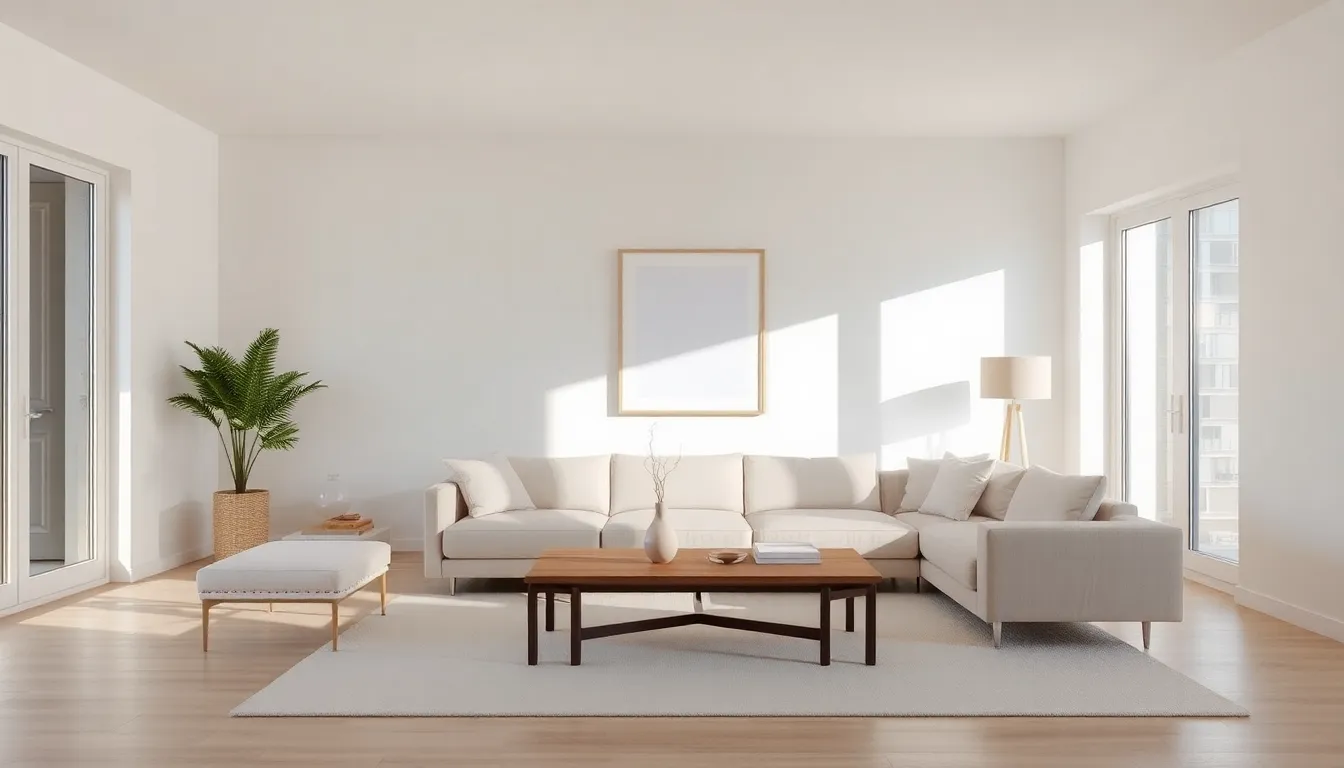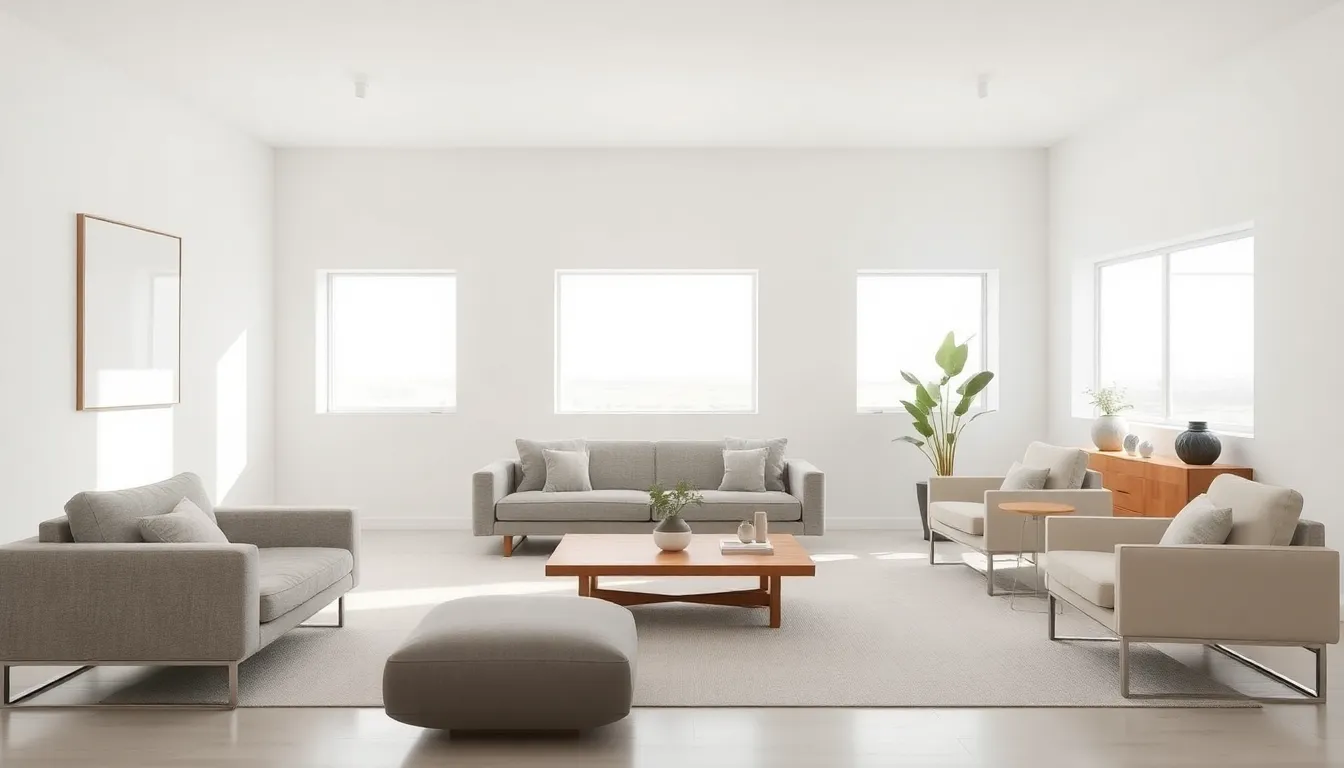Picture this: a living room so serene, you can almost hear the calm. They say less is more, and in the world of interior design, that couldn’t be truer. Minimalist living room design isn’t just about removing clutter: it’s an art form, easy on the eyes and even easier to maintain. Let’s jump into minimalist living room design ideas that might just inspire you to throw out that dusty old recliner and go for something classy yet simple. Get ready to create a space that speaks volumes without saying a word.
Table of Contents
ToggleUnderstanding Minimalism in Interior Design

Minimalism is more than a trend: it’s a lifestyle choice. At its core, it centers around creating spaces that emphasize simplicity and functionality. Imagine entering a room with clean lines, purposeful spaces, and a sense of tranquility. Minimalist living rooms often have a calm atmosphere, inviting relaxation and clarity of mind. This design philosophy encourages individuals to evaluate their belongings, keeping only what adds value to their lives. In essence, minimalism advocates for quality over quantity, encouraging thoughtful selections throughout the space.
Key Principles of Minimalist Living Rooms
To truly capture the essence of minimalist living rooms, several key principles come into play:
- Clarity and Simplicity: A minimalist space should never feel crowded or chaotic. Opt for fewer pieces that have impact, allowing each to stand out in its own right.
- Functionality: Every item should serve a purpose. From furniture to decor, each piece should enrich the living experience.
- Neutral Colors: Minimalist designs often use a neutral color palette, promoting a sense of calm and space.
- Natural Light: Emphasizing light sources enhances the openness of a room, making it feel airy and spacious.
- Quality Materials: Investing in well-crafted items creates an enduring aesthetic that stands the test of time.
Color Palettes for a Minimalist Living Room
Choosing the right color palette is essential in achieving that minimalist look. Stick with neutral tones such as whites, blacks, grays, and beige. These colors provide a clean backdrop that emphasizes simplicity. If monotone feels too dull, incorporate some accent colors, but keep them muted. An olive green, earthy terracotta, or a soft blue can add character without overwhelming the senses. The key is balance: ensure that colors complement rather than compete for attention.
Furniture Selection for Minimalist Spaces
When selecting furniture for a minimalist living room, prioritize simplicity and functionality. Look for items with clean lines and minimal detailing. Sofas in muted colors can anchor the space without dominating it. Coffee tables that are simple yet stylish are perfect for maintaining the uncluttered aesthetic. Multi-functional furniture, such as ottomans that double as storage, enhances usability without adding clutter. Remember, it’s not about filling up the space: it’s about what’s truly necessary.
Incorporating Essential Decor
In a minimalist living room, decor should highlight the principle of ‘less is more.’ Choose a few standout pieces, perhaps a striking piece of art or a unique sculpture, that call for attention without overwhelming the space. Textiles, like throws or cushions, can add warmth and softness. But, opt for those with subtle patterns or textures to stay within the minimalist theme. Plants are also a great addition, bringing life and vibrancy while keeping the atmosphere fresh.
Maximizing Space and Light in Minimalist Designs
A hallmark of minimalist design is creating a sense of expanded space. Start by decluttering surfaces to encourage openness. Use mirrors strategically to reflect light and give the illusion of a larger area. Think about your furniture arrangement: make use of vertical space by hanging shelves instead of using bulky bookcases. Natural light should flow unobstructed: opt for sheer curtains that allow brightness while maintaining privacy. Remember, an airy atmosphere promotes the calming essence of minimalism.
Practical Tips for Implementing Minimalism
Adopting a minimalist living room design doesn’t happen overnight. Here are some practical tips to integrate minimalism into your space:
- Start Small: Begin with one area, like a coffee table or shelf. Gradually work your way through the entire room.
- Question Utility: Ask yourself if each item brings joy or serves a purpose. If not, consider parting ways.
- Think Before You Buy: Each addition should reflect the minimalist ethos. A thoughtful approach to purchasing can significantly impact your space.
- Go Digital: For books, photos, and other items, consider digital alternatives to reduce physical clutter.







